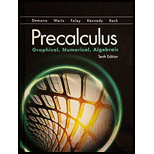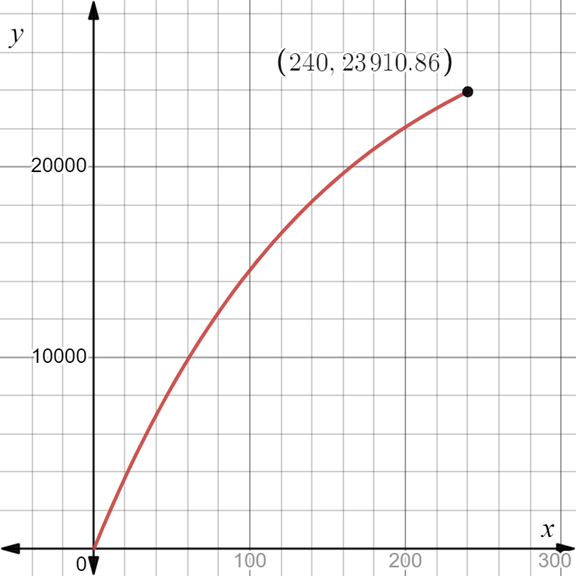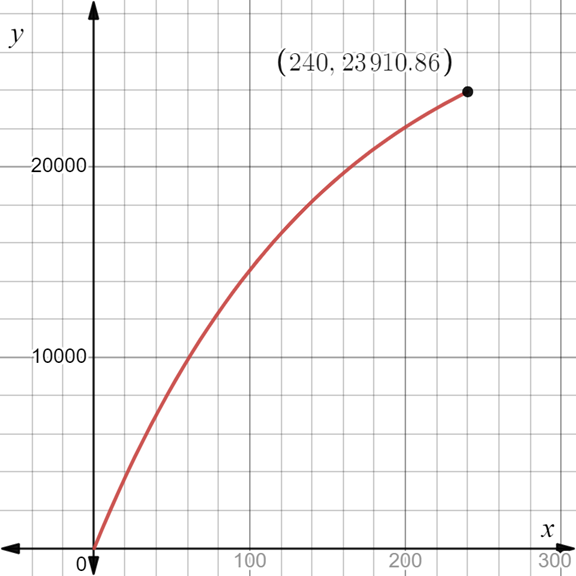
a.
To find: The annual interest rate.
The annual interest rate is 8%.
Given information:
The function describes the present value of a certain annuity, where x is time in months:
Concept used:
The present value PV of an annuity consisting of n equal payments of R dollars earning an interest rate i per period (payment interval) is
Explanation:
The annual interest rate is determined by the term 0.08 i.e., 8%.
b.
To find: The number of payments per year.
There are 12 payments per year.
Given information:
The function describes the present value of a certain annuity, where x is time in months:
Concept used:
The present value PV of an annuity consisting of n equal payments of R dollars earning an interest rate i per period (payment interval) is
Explanation:
Here, in the given equation “12” determines the number of payments per year.
c.
To find: The amount of each payment.
The amount of each payment is $200.
Given information:
The function describes the present value of a certain annuity, where x is time in months:
Concept used:
The present value PV of an annuity consisting of n equal payments of R dollars earning an interest rate i per period (payment interval) is
Explanation:
On comparing the formula,
i.e., The amount of each payment is $200.
d.
To compute: The present value of the annuity paying $200 monthly after 20 years.
The present value of the annuity is $23,910.86.
Given information:
The function describes the present value of a certain annuity, where x is time in months:
Concept used:
The present value PV of an annuity consisting of n equal payments of R dollars earning an interest rate i per period (payment interval) is
Explanation:
Substitute
The present value of the annuity paying $200 monthly after 20 years is $23,910.86.
e.
To graph: The present value function for x in the interval 0 to 20 years.
The graph of the present value function for x in the interval 0 to 20 years is shown.

Given information:
The function describes the present value of a certain annuity, where x is time in months:
Concept used:
The present value PV of an annuity consisting of n equal payments of R dollars earning an interest rate i per period (payment interval) is
Explanation:
By using graphing calculator, plot the given expression.

f.
To explain: The amount $23,910.86 is much less than the total of all 240 monthly payments of $200, which is $4800.
$23,910.86 is the present value of the annuity paying $200 monthly after 20 years.
Its future value will be much higher than $48,000.
$23,910.86 as present value would be a better option for now.
Given information:
The function describes the present value of a certain annuity, where x is time in months:
Concept used:
The present value PV of an annuity consisting of n equal payments of R dollars earning an interest rate i per period (payment interval) is
Explanation:
$23,910.86 is the present value of the annuity paying $200 monthly after 20 years.
Its future value will be much higher than $48,000.
Thus, $23,910.86 as present value would be a better option for now.
Chapter 3 Solutions
EBK PRECALCULUS:GRAPHICAL,...-NASTA ED.
- Find the tangent line approximation 7 to the graph of f at the given point. T(x) = f(x) = csc(x), (8, csc(8)) Complete the table. (Round your answers to four decimal places.) x f(x) T(x) 7.9 7.99 8 8.01 8.1arrow_forwardCan you solve it numerical methodarrow_forwardUse the information to find and compare Ay and dy. (Round your answers to four decimal places.) Function x-Value Differential of x Ду = dy = y = x² + 2 x = -4 Ax = dx = 0.01arrow_forward
- Calculus lll May I please have the statements with blank lines completed; furthermore, may I please have the text box completed? Thank youarrow_forwardCalculus lll May I please have the statements completed for the following text lines and box? Thank you so much,arrow_forwardCalculus lll May I please have the solution for the following exercise? Thank you so mucharrow_forward
- Calculus lll May I please have the statement completed for the following box? Thank you so much,arrow_forwardCalculus lll May I please have the solution for the following exercise? Thank you so mucharrow_forwardUse a graphing calculator to find where the curves intersect and to find the area between the curves. y=ex, y=-x²-4x a. The left point of intersection is (Type integers or decimals rounded to the nearest thousandth as needed. Type an ordered pair.)arrow_forward
 Calculus: Early TranscendentalsCalculusISBN:9781285741550Author:James StewartPublisher:Cengage Learning
Calculus: Early TranscendentalsCalculusISBN:9781285741550Author:James StewartPublisher:Cengage Learning Thomas' Calculus (14th Edition)CalculusISBN:9780134438986Author:Joel R. Hass, Christopher E. Heil, Maurice D. WeirPublisher:PEARSON
Thomas' Calculus (14th Edition)CalculusISBN:9780134438986Author:Joel R. Hass, Christopher E. Heil, Maurice D. WeirPublisher:PEARSON Calculus: Early Transcendentals (3rd Edition)CalculusISBN:9780134763644Author:William L. Briggs, Lyle Cochran, Bernard Gillett, Eric SchulzPublisher:PEARSON
Calculus: Early Transcendentals (3rd Edition)CalculusISBN:9780134763644Author:William L. Briggs, Lyle Cochran, Bernard Gillett, Eric SchulzPublisher:PEARSON Calculus: Early TranscendentalsCalculusISBN:9781319050740Author:Jon Rogawski, Colin Adams, Robert FranzosaPublisher:W. H. Freeman
Calculus: Early TranscendentalsCalculusISBN:9781319050740Author:Jon Rogawski, Colin Adams, Robert FranzosaPublisher:W. H. Freeman
 Calculus: Early Transcendental FunctionsCalculusISBN:9781337552516Author:Ron Larson, Bruce H. EdwardsPublisher:Cengage Learning
Calculus: Early Transcendental FunctionsCalculusISBN:9781337552516Author:Ron Larson, Bruce H. EdwardsPublisher:Cengage Learning





